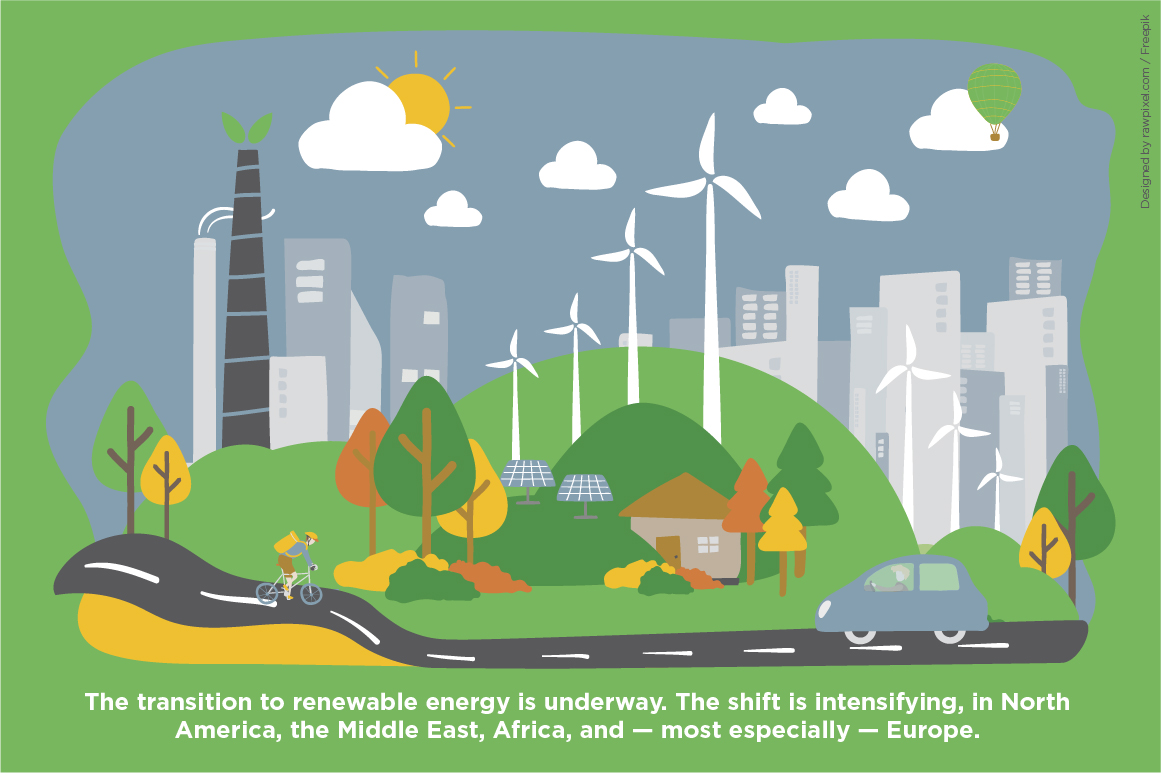The transition to renewable energy — and distancing from traditional, carbon-based sources like petroleum and natural gas — isn’t about to happen or on the cusp of taking place. In several parts of the world, it’s already underway. The shift is intensifying, in North America, the Middle East, Africa, and — most especially — Europe.
In the U.S., approximately 60% of the nation’s energy supply derives from fossil fuels, according to the most recent figures available from the Energy Information Administration. Of this total, 40% is natural gas and around 19% is coal. Meanwhile, renewables like wind, hydropower, geothermal, and solar account for roughly 20%. As recently as 2018, however, renewables represented only 16% and fossil fuels 84% based on data from the Pew Research Center. That’s a notable growth rate.
But in several European countries, the transition has moved more expeditiously, with the energy supply composition almost a reversal of the United States’ numbers. That’s particularly the case in Sweden, where more than half of the country’s power consumption comes from renewables, with Finland, Latvia, and Denmark, not far behind according to figures from Eurostat. Denmark has set a 2030 goal to be almost 100% dependent on renewable energy, relying mostly on wind, according to Energy Global. So far, the Nordic nation appears to be on track to achieving that mark.
Bottom line: Given the data, the renewable energy revolution is clearly here to stay. And if oil and gas suppliers seek to remain solvent and competitive, it’s incumbent upon them to adopt the technologies, processes, and practices that are in keeping with these global trends to diminish carbon emissions.
However, like so many aspects of life and business, getting there will be easier said than done.

Very different supply chains structures
Part of this challenge has to do with the way traditional energies — such as natural gas, coal, and oil — are produced and disseminated relative to renewable energy.
While both petroleum and natural gas are used to heat homes and power motor vehicles once properly refined, they’re also used to make everyday items like plastics, bicycle helmets, medical devices, even the turbines used at wind farms. Refining produces the petrochemicals that are needed to turn those liquids into these and other solids. Because each process is very different from the next, the supply chain is highly circuitous and designed accordingly to supply parts to refineries and transport semi-liquid and gas products. Thus, with oil and gas, the supply chain includes processes related to delivery, refining, and production.
The renewable energy supply chain is much more streamlined compared to traditional energy; it’s almost entirely focused on the production and conversion to power homes, businesses, and equipment. Through various systems, techniques, and strategies that rely on a combination of industrial manufacturing and state-of-the-art technologies, the supply chain for sun (solar), water (hydro), wind, and geothermal are entirely different from that of oil and gas.
Oil and gas producers are mostly on their own
Another challenge traditional suppliers face is the social and political environment. Governments and alliances, like the European Union, are providing funding and launching programs aimed at green energy entities. Instead of providing solutions to oil and gas companies to help reduce their carbon emissions and establish better carbon management capabilities, they are more interested in helping renewable energy companies expand their foothold in a global market where traditional energy companies (for now) maintain the largest share of the production pie.
And, just as governments are distancing themselves from fossil fuels, many consumers are supportive of that move as well — 60% favor reducing fossil fuels according to polling conducted by Gallup.
In the private sector, businesses are joining forces toward a more sustainable, renewable energy future. This includes Aker Solutions, DeepOcean, and Solstad Offshore, which recently announced the launch of their Offshore Renewables Alliance. Its mission is to “offer product deliveries, fabrication services as well as marine and subsea operations … within offshore renewables industries.”
Several traditional energy suppliers have taken steps toward carbon reduction or neutrality, but much like the shift toward a power grid that leverages renewables, it will take time to lay the appropriate supply chain groundwork. Given the more expedited pace of the transition, time is running out for those who haven’t taken any steps yet.

For oil and gas companies on any stage of this journey, Inspirage is here to help. Inspirage is uniquely qualified and well-seasoned to assist, with the help of Oracle Cloud solutions, traditional energy producers build a more optimized supply chain that improves profitability and productivity. As an experienced and award-winning Oracle Platinum Partner, Inspirage can implement, manage, and control new and transitioning supply chains by leveraging best practices that are proven to help organizations achieve their goals and endure the growing pains related to change.
Contact us today to learn more.